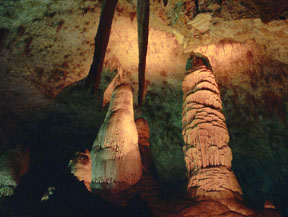
Long House Cliff Dwelling
Bandelier National Monument
The Long House Cliff Dwelling is an 800-foot (244 meter) stretch of multi-storied rooms carved into the cliff of volcanic ash from the Jemez Caldera to the northwest. These were built by the Ancient Puebloans (formerly referred to as Anazasi) during their nearly 500 year occupation of the area which ended in the late 1500s with the Spanish colonization of New Mexico.
Print No. A97SW-14-10
Stalactites, Carlsbad Caverns
Carlsbad Caverns lies on the eastern tip of the Guadalupe Mountains in the southeastern part of the state. The limestone that the caves form in was a coral reef in an inland sea 250 million years ago. The stalactites are the narrow dripstones hanging down from the roof of a cave.
Print No. B96-5

Stalagmites, Carlsbad Caverns
stalagmites are the broader dripstones sticking up from the floor of the cave. Typically there will be one or more associated stalactites overhead feeding the stalagmite with mineral-rich water. Sometimes, if there's sufficient time and/or mineral-rich flow, the stalactites and associated stalagmites will connect, forming a pillar.
Print No. B96-4
Bats Take Flight, Carlsbad Caverns
From mid-May through September, the 16 species of bats living in portions of the caverns take flight at sunset. Hundreds of thousands of bats gradually make their way out of the main entrance only with the help of their sheer numbers. The vertical opening of the main entrance is wide enough for bats to enter and begin flying around counterclockwise. As they fill up the opening, they create their own vortex, virtually a mini-tornado, eventually providing just enough lift to carry them over the edge and out to feed on insects during the evening. All this has to happen because they don't have the individual ability to fly up vertically. It takes hours for all of the bats to make their way out. Here's a close-up of the bats.
Print No. B96-3
Shiprock
Shiprock, located in the northwest corner of New Mexico, is the eroded remnant of a volcano. Here it is comprised of the central conduit (volcanic neck), seen in the background, and radiating dikes, like the one in the foreground. Shiprock is part of the Navajo Volcanic Field, which spans the Four Corners area. These Oligocene-age volcanoes erupted 25 to 30 million years ago.
Print No. A03-13-3
Ice Cave, El Malpais
Forming in a collapsed lava tube associated with the 10,000 year old Bandera Volcano, the ice on the floor of the cave is about 20 feet (6 meters) thick. The deepest ice dates back 3,400 years. It forms here as the cave is well insulated and never gets above 31oF (-0.6.oC). The green tints are caused by an arctic algae.
Print No. A97SW-12-4




